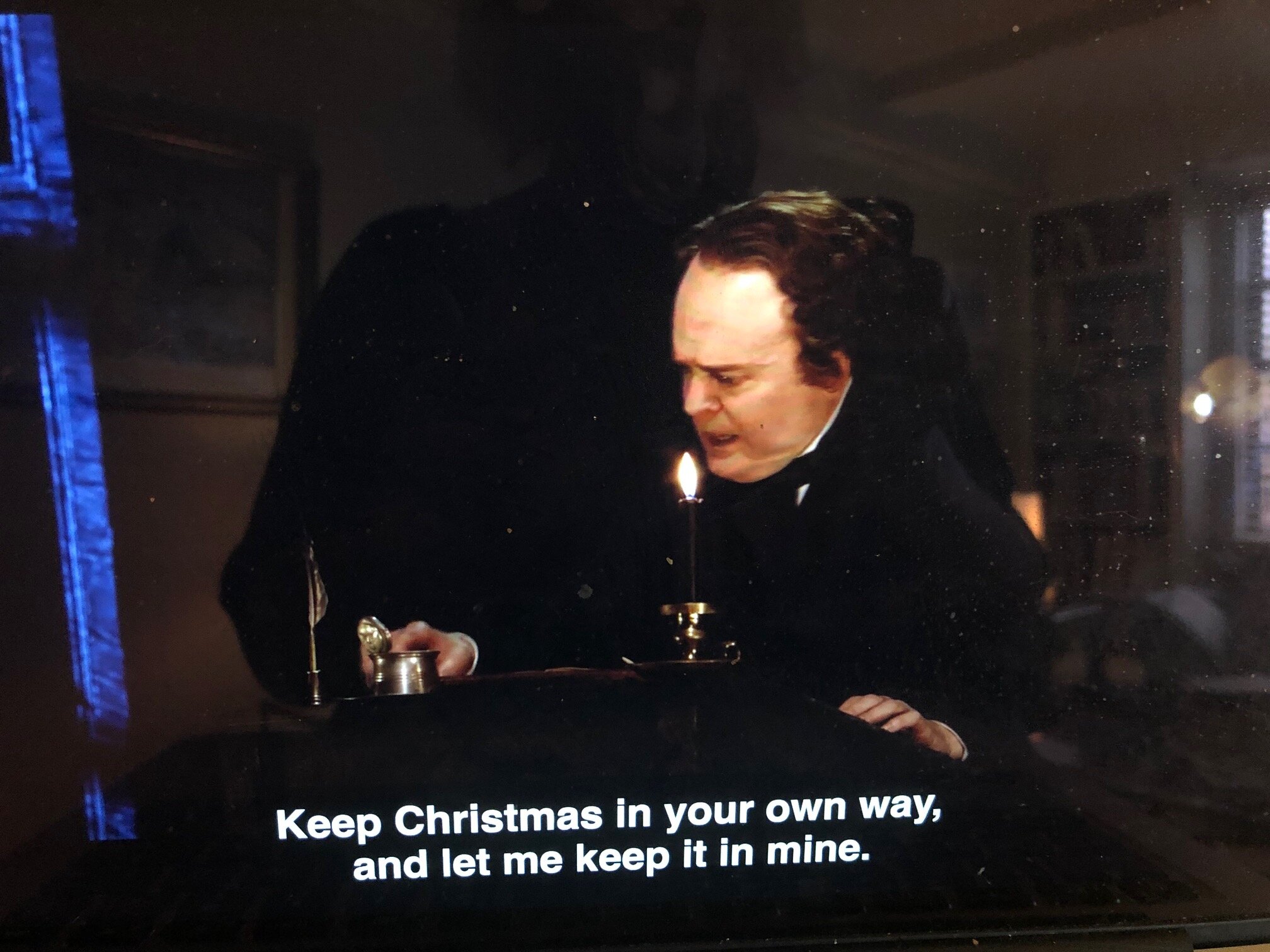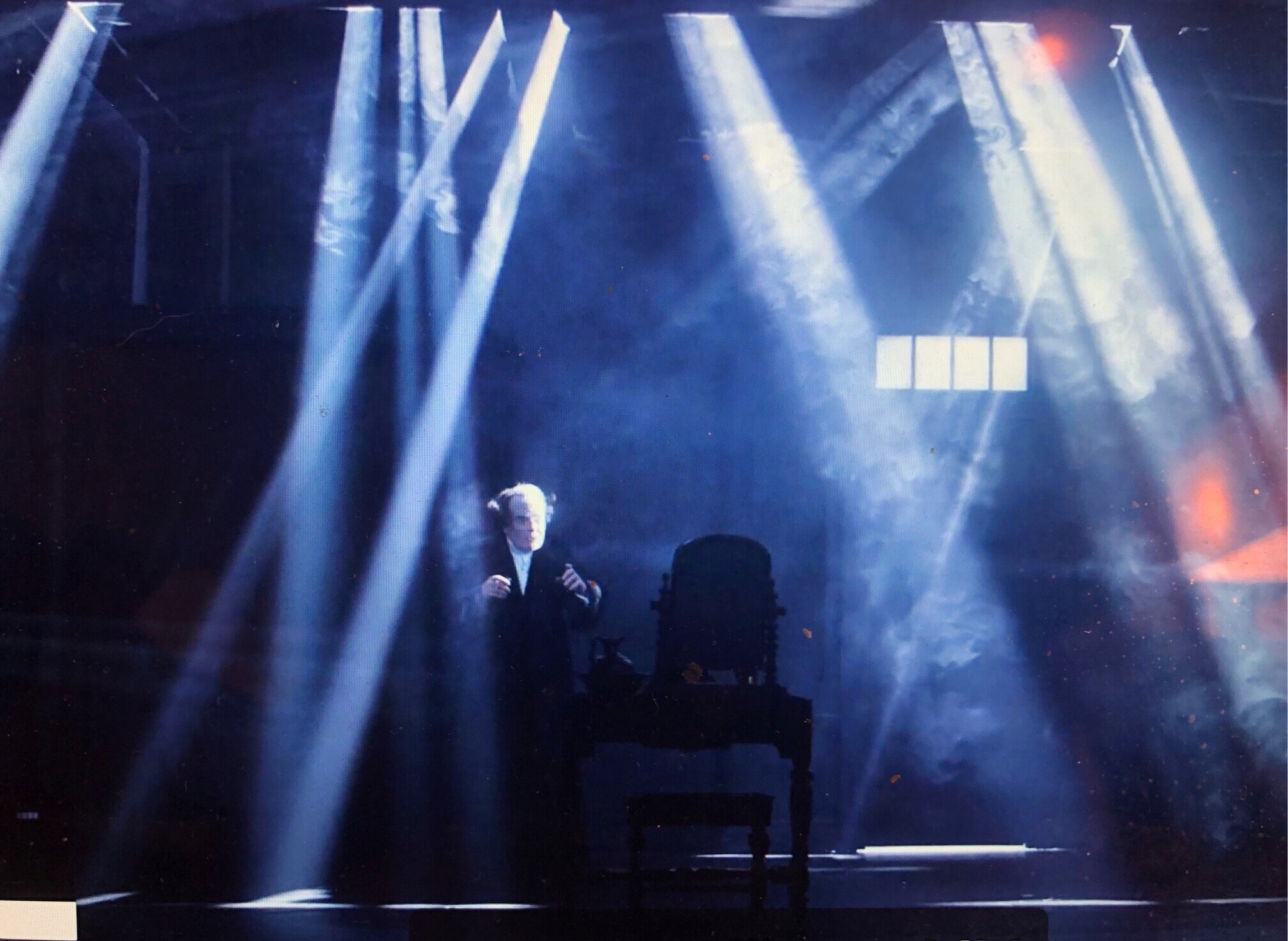THE MAN WHO CAME TO DINNER Ebenezer Scrooge (Jefferson Mays), during his middle-of-the-night vision, finds himself in his nephew’s London townhouse, in this new one-man-show streaming version of “A Christmas Carol.”
IF CHARLES DICKENS HIMSELF could do readings of “A Christmas Carol,” his 1843 novella, all by himself, why not an actual actor? Patrick Stewart did a low-tech version on Broadway in the 1990s. Now Jefferson Mays, the Tony, Drama Desk, Obie and Theater World Award winner who became a Broadway star with “I Am My Own Wife” (2003), takes on the challenge in the age of Covid. And not surprisingly, he does rather well.
O.K., the man has help. The otherworldly voices he does for Marley’s Ghost and others are electronically enhanced, owing a great deal to Joshua D. Reid, the sound designer. And then there are the other effects — as one Los Angeles critic put it in 2018, when the production was onstage at the Geffen Playhouse, “every bit of theater magic you can think of.”
WORLD’S WORST BOSS Scrooge at the office in his usual cheery mood. (The captions are optional. Here at Press Nights, we like them because we take a deranged pleasure in criticizing other people’s punctuation. This sentence gets an A+; note the comma preceding the independent clause.)
Here’s the story, for the three people on the planet who don’t know it:
_______________________________
Ebenezer Scrooge, a grouchy financier in mid-19th-century London, is so mean that on Christmas Eve he turns away charity solicitors and caroling children alike with a gruff “Bah, humbug!” and worse. People who don’t have enough money for a nice holiday dinner? Scrooge wishes them dead.
But that evening — which Scrooge is spending alone eating gruel in front of the fireplace (and there isn’t even a pandemic) — the ghost of his old business partner, miserable in the afterlife, visits him and sends three spirits in the middle of the night to show him what a monster he’s been.
.
SPIRIT IN THE AIR Scrooge seems apprehensive as the first Christmas spirit makes its entrance. Yes, that red light in the photo’s upper right is the Ghost of Christmas Past. Scrooge’s past.
.The intervention is a success, and on Christmas morning, Scrooge is a changed man, sending the poultry shop’s biggest turkey to a poor family, going to his nephew’s for a festive dinner with a spring in his step and suddenly understanding how to honor the holiday both outwardly and in his heart.
_______________________________
Now I hear you saying that you’ve seen “A Christmas Carol” a hundred times. You can recite every line by heart and describe every costume. To you, I say: Keep in mind that what Dickens wrote was the length of a short novel. Every version you’ve ever seen, from Alastair Sim to the Muppets, has picked and chosen the dialogue and narration it considers most important — and left out the rest.
In “A Christmas Carol Live,” Scrooge does say “Bah, humbug”; Tiny Tim does lean on his crutch and ask God to “bless us, every one”; and Marley’s Ghost does wail “Mankind was my business!” with the tortured voice of the damned. But you may actually also hear lines you’ve never heard before.
BEST OFFICE CHRISTMAS PARTY EVER. Led by the Ghost of Christmas Past, Scrooge visits Fezziwig’s, where he apprenticed as a young man. The office closes early on Christmas Eve for some dancing, fiddling, drinking and miscellaneous joy.
You’ll get a taste of Dickens’s passion for language. He never met a string of serial adjectives he didn’t like. Fezziwig called out in a “comfortable, oily, rich, fat, jovial voice.” And the author knew the power of simplicity. When he describes Scrooge’s depressing home, he writes, “Darkness was cheap, and Scrooge liked it.”
And if solo shows annoy you because there’s no visual variety — let us introduce you to Dane Laffrey, the production designer (who also co-conceived the show, with the director Michael Arden); Ben Stanton, the lighting designer; and Lucy Mackinnon, the projection designer.
WAITING FOR TINY TIM . Scrooge visits the home of his clerk, Bob Cratchit, as Mrs. Cratchit and the children prepare for the family’s Christmas feast.
At first, this “A Christmas Carol” is dark and gloomy — like its protagonist. A man in black carries one lighted candle to his tiny, high office desk. In some early scenes, the only other light is a fireplace (stage left).
Then suddenly there’s a projection filled with movement and light — We can see the office Christmas party at the establishment run by Mr. Fezziwig, Scrooge’s lovable long-ago boss. Through the windows, we see dancing couples twirling, fiddlers fiddling and merriment being made. Later we see the Ghost of Christmas Present in a room filled with enough holiday meats and accoutrements to feed an army — and that blazing fireplace (stage left).
Then, just as we’re thinking “Oh, that’s a beautiful projection of Scrooge’s nephew, Fred’s, dining room,” Mays walks right into it, strolling the length of the long, candelabra-laden table. It’s not a projection; it’s a set. And when the lights do come on in Scrooge’s world, from ghostly entrance lighting to the blessings of heaven shining upon the Cratchits’ humble home, they illuminate a lot more than the furniture.
VICTORIAN MEAT EATER What could make a chronic grump smile so sincerely? Lots and lots and lots of holiday food in the room where the Spirit of Christmas Present is presiding.
Mays is, despite all evidence to the contrary, an American — born in Connecticut and educated at Yale before he went to California for his master’s. He’s accustomed to praise. Jesse Green’s review of the streaming production (in the Dec. 1, 2020, print edition of The New York Times) even liked his portrayal of a potato crying out to be removed from the heat and peeled.
Green also called the production “more than a tour de force,” declaring it a case of having made “what was already a classic story feel new, while also making it feel as if it should matter forever.”
I will add the most generous compliment I can think of. By the time Scrooge was teleporting all over with the second ghost, I’d completely forgotten to pay attention to how one actor was playing more than 50 characters. The device had dissolved smoothly into the artistry.
“A Christmas Carol,” by Charles Dickens. Adaptation by Jefferson Mays, Susan Lyons and Michael Arden. Directed by Arden. Filmed at United Palace. Available to stream from Nov. 28, 2020, through Jan. 3, 2021. $57.50 (including all fees). https://www.achristmascarollive.com






